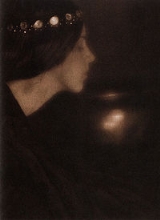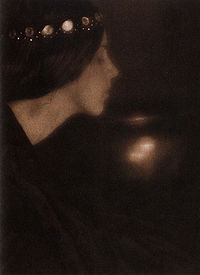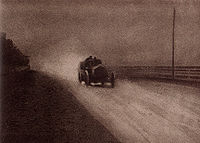
Pictorialism
Encyclopedia
 Pictorialism is the name given to a photographic
Pictorialism is the name given to a photographic
movement in vogue from around 1885 following the widespread introduction of the dry-plate process. It reached its height in the early years of the 20th century, and declined rapidly after 1914 after the widespread emergence of Modernism
. The terms "Pictorialism" and "Pictorialist" entered common use only after 1900.
Pictorialism largely subscribed to the idea that art photography needed to emulate the painting
and etching
of the time. Most of these pictures were black & white or sepia-toned. Among the methods used were soft focus
, special filters and lens coatings, heavy manipulation in the darkroom
, and exotic printing processes. From 1898 rough-surface printing papers were added to the repertoire, to further break up a picture's sharpness. Some artists "etched" the surface of their prints using fine needles. The aim of such techniques was to achieve what the 1911 Encyclopædia Britannica termed, in discussing pictorial photography, "personal artistic expression".
Despite the aim of artistic expression, the best of such photographs paralleled the impressionist
style then current in painting. Looking back from the present day, we can also see close parallel between the composition and picturesque subject of genre paintings and the bulk of pictorialist photography.
 The 1911 Encyclopædia Britannica noted that: "as a distinct movement pictorial photography is essentially of British origin", although in its later phases there was a strong influence on American photography. The British Brotherhood of the Linked Ring and The New American School were organised groups in Pictorialism around 1900. An American circle of photographers later renounced pictorialism altogether and went on to found Group f/64
The 1911 Encyclopædia Britannica noted that: "as a distinct movement pictorial photography is essentially of British origin", although in its later phases there was a strong influence on American photography. The British Brotherhood of the Linked Ring and The New American School were organised groups in Pictorialism around 1900. An American circle of photographers later renounced pictorialism altogether and went on to found Group f/64
, which espoused the ideal of unmanipulated, or straight photography
.
One of the most important publications that promoted Pictorialism was Alfred Stieglitz
's "Camera Work
" 1903 - 1917. Each publication had up to 12 plates that were reproduced in Photogravure
, Halftone
or Collotype
. These plates are now collected and very sought after in the art world. Most of the photographers that made up the issues were members of the Photo-Secession
, a group that promoted photography as art and soon moved away from the ideals of pictorialism.
By the year of 1910, when Albright Gallery bought 15 photographs from Stieglitz' 291 Gallery, a major victory was won in the battle for establishing photography as art. Pictorialism, which had served to open the museum doors for photography, was now already regarded as a vision of the past by the spearheading photographers of that time. Stieglitz, always craving for the new, was quoted around 1910 saying "It is high time that the stupidity and sham in pictorial photography be struck a solarplexus blow." Additionally, "Claims of art won't do. Let the photographer make a perfect photograph. And if he happens to be a lover of perfection and a seer, the resulting photograph will be straight and beautiful - a true photograph."
The new and proceedingly modern America needed a new representation in art. This necessarily meant the end for pictorialism as major form of art, although the contemporary American portraitist Sally Mann
revisited the pictorialist style in her 2003 book What Remains.

Photography
Photography is the art, science and practice of creating durable images by recording light or other electromagnetic radiation, either electronically by means of an image sensor or chemically by means of a light-sensitive material such as photographic film...
movement in vogue from around 1885 following the widespread introduction of the dry-plate process. It reached its height in the early years of the 20th century, and declined rapidly after 1914 after the widespread emergence of Modernism
Modernism
Modernism, in its broadest definition, is modern thought, character, or practice. More specifically, the term describes the modernist movement, its set of cultural tendencies and array of associated cultural movements, originally arising from wide-scale and far-reaching changes to Western society...
. The terms "Pictorialism" and "Pictorialist" entered common use only after 1900.
Pictorialism largely subscribed to the idea that art photography needed to emulate the painting
Painting
Painting is the practice of applying paint, pigment, color or other medium to a surface . The application of the medium is commonly applied to the base with a brush but other objects can be used. In art, the term painting describes both the act and the result of the action. However, painting is...
and etching
Etching
Etching is the process of using strong acid or mordant to cut into the unprotected parts of a metal surface to create a design in intaglio in the metal...
of the time. Most of these pictures were black & white or sepia-toned. Among the methods used were soft focus
Soft focus
In photography, soft focus is a lens flaw, in which the lens forms images that are blurred due to spherical aberration. A soft focus lens deliberately introduces spherical aberration in order to give the appearance of blurring the image while retaining sharp edges; it is not the same as an...
, special filters and lens coatings, heavy manipulation in the darkroom
Darkroom
A darkroom is a room that can be made completely dark to allow the processing of light sensitive photographic materials, including photographic film and photographic paper. Darkrooms have been created and used since the inception of photography in the early 19th century...
, and exotic printing processes. From 1898 rough-surface printing papers were added to the repertoire, to further break up a picture's sharpness. Some artists "etched" the surface of their prints using fine needles. The aim of such techniques was to achieve what the 1911 Encyclopædia Britannica termed, in discussing pictorial photography, "personal artistic expression".
Despite the aim of artistic expression, the best of such photographs paralleled the impressionist
Impressionism
Impressionism was a 19th-century art movement that originated with a group of Paris-based artists whose independent exhibitions brought them to prominence during the 1870s and 1880s...
style then current in painting. Looking back from the present day, we can also see close parallel between the composition and picturesque subject of genre paintings and the bulk of pictorialist photography.

Group f/64
Group f/64 was a group of seven 20th century San Francisco photographers who shared a common photographic style characterized by sharp-focused and carefully framed images seen through a particularly Western viewpoint...
, which espoused the ideal of unmanipulated, or straight photography
Straight photography
Pure photography or straight photography refers to photography that attempts to depict a scene as realistically and objectively as permitted by the medium, renouncing the use of manipulation....
.
One of the most important publications that promoted Pictorialism was Alfred Stieglitz
Alfred Stieglitz
Alfred Stieglitz was an American photographer and modern art promoter who was instrumental over his fifty-year career in making photography an accepted art form...
's "Camera Work
Camera Work
Camera Work was a quarterly photographic journal published by Alfred Stieglitz from 1903 to 1917. It is known for its many high-quality photogravures by some of the most important photographers in the world and its editorial purpose to establish photography as a fine art...
" 1903 - 1917. Each publication had up to 12 plates that were reproduced in Photogravure
Photogravure
Photogravure is an intaglio printmaking or photo-mechanical process whereby a copper plate is coated with a light-sensitive gelatin tissue which had been exposed to a film positive, and then etched, resulting in a high quality intaglio print that can reproduce the detail and continuous tones of a...
, Halftone
Halftone
Halftone is the reprographic technique that simulates continuous tone imagery through the use of dots, varying either in size, in shape or in spacing...
or Collotype
Collotype
Collotype is a dichromate-based photographic process invented by Alphonse Poitevin in 1856. and was used for large volume mechanical printing before the existence of cheaper offset lithography. It can produce results difficult to distinguish from metal-based photographic prints because of its...
. These plates are now collected and very sought after in the art world. Most of the photographers that made up the issues were members of the Photo-Secession
Photo-Secession
The Photo-Secession was an early 20th century movement that promoted photography as a fine art in general and photographic pictorialism in particular. A group of photographers, led by Alfred Stieglitz and F...
, a group that promoted photography as art and soon moved away from the ideals of pictorialism.
By the year of 1910, when Albright Gallery bought 15 photographs from Stieglitz' 291 Gallery, a major victory was won in the battle for establishing photography as art. Pictorialism, which had served to open the museum doors for photography, was now already regarded as a vision of the past by the spearheading photographers of that time. Stieglitz, always craving for the new, was quoted around 1910 saying "It is high time that the stupidity and sham in pictorial photography be struck a solarplexus blow." Additionally, "Claims of art won't do. Let the photographer make a perfect photograph. And if he happens to be a lover of perfection and a seer, the resulting photograph will be straight and beautiful - a true photograph."
The new and proceedingly modern America needed a new representation in art. This necessarily meant the end for pictorialism as major form of art, although the contemporary American portraitist Sally Mann
Sally Mann
Sally Mann is an American photographer, best known for her large black-and-white photographs—at first of her young children, then later of landscapes suggesting decay and death.-Early life and education:...
revisited the pictorialist style in her 2003 book What Remains.
Artists
- Robert DemachyRobert DemachyRobert Demachy was a prominent French Pictorial photographer of the late 19th and early 20th century. He is best known for his intensely manipulated prints that display a distinct painterly quality.-Early years :...
(1859-1936), French - Pierre DubreuilPierre DubreuilPierre Dubreuil, born in Lille in 1872 and died in Grenoble in 1944, was a French photographer.- Biography :Pierre Dubreuil was born in a wealthy family, well-established in the wallpaper trade. In 1888 he joined the Jesuit College of Saint-Joseph in Lille and started to take pictures with a...
(1872-1944), French - Peter Henry EmersonPeter Henry EmersonPeter Henry Emerson was a British writer and photographer. His photographs are early examples of promoting photography as an art form...
(1856-1936), English - Frederick EvansFrederick EvansFrederick Evans may refer to: * Frederick H. Evans , British photographer, primarily of architectural subjects*Frederick John Owen Evans* Fred Evans , British music hall and silent movie comedian...
(1853-1943), English - Emile Frechon (1848-1921), French
- Gertrude KäsebierGertrude KäsebierGertrude Käsebier was one of the most influential American photographers of the early 20th century. She was known for her evocative images of motherhood, her powerful portraits of Native Americans and her promotion of photography as a career for women.-Early life :Käsebier was born Gertrude...
(1852-1934), américan - Heinrich KühnHeinrich KühnCarl Christian Heinrich Kühn was an Austrian Photographer and Pioneer.He is regarded one of the forefathers of fine art photography, the movement that helped photography to establish itself as an art on its own. His photographs closely resemble Impressionist paintings, with their frequent use of...
(1866-1944), Austrian - Eugene LemaireEugene LemaireEugène Lemaire was a Belgian pictorialist photographer. He is an excellent artist of portrait and still life.He was a friend of Léonard Misonne.- Exhibitions :...
(1874-1948), Belgian - Gustave Marissiaux (1872-1929), Belgian
- Léonard Missone (1870-1943), Belgian
- Constant PuyoConstant PuyoÉmile Joachim Constant Puyo was a French photographer, active in the late 19th and early 20th centuries. As the leading advocate of the Pictorialist movement in France, he championed the practice of photography as an artistic medium...
(1857-1933), French - Fernand Bignon (1888-1969), French
- Edward SteichenEdward SteichenEdward J. Steichen was an American photographer, painter, and art gallery and museum curator. He was the most frequently featured photographer in Alfred Stieglitz' groundbreaking magazine Camera Work during its run from 1903 to 1917. Steichen also contributed the logo design and a custom typeface...
(1879-1973), Américan - Alfred StieglitzAlfred StieglitzAlfred Stieglitz was an American photographer and modern art promoter who was instrumental over his fifty-year career in making photography an accepted art form...
(1864-1946), Américan
Further reading
- Daum, Patrick (Ed.) Impressionist Camera: Pictorial Photography in Europe, 1888-1918 (2006). ISBN 1-85894-331-0
- Taschen "Alfred Stieglitz Camera Work, The complete illustrations 1903-1917 (1997). ISBN 3-8228-8072-8
- Green, Jonathan "Camera Work: A Critical Anthology (1973). ISBN 0-912334-73-8
External links
- In Praise of Pictorialism: Early Pictorial Photography. A discussion on pictorial photography and 28 examples of this style.

